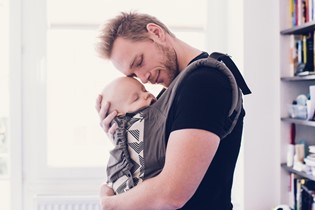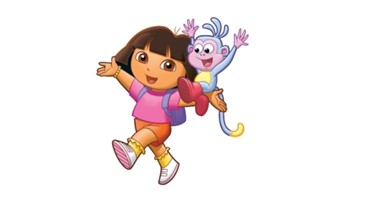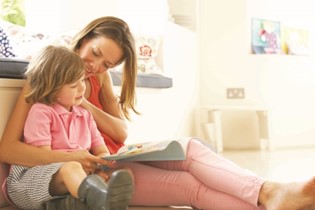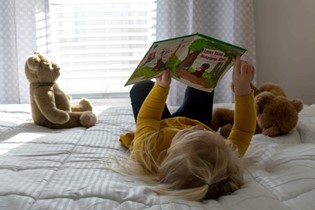Cranial Osteopathy - How Does It Work?
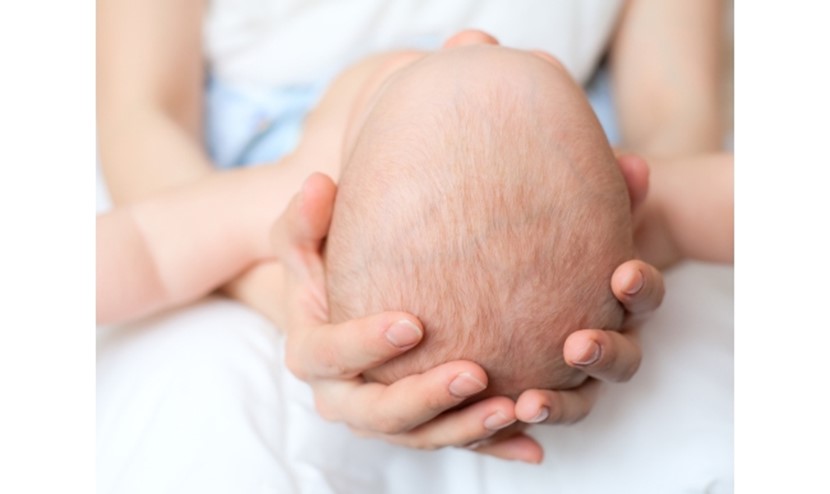
What is cranial osteopathy and how can it help your crying baby? Auckland osteopath Felice Karuna explains the potential benefits and how it works.
Parents usually arrive at a cranial osteopathy clinic in a state of desperation, hoping for some relief for their unsettled, crying, sleepless infant. While for a few parents it is the “done thing” to take a newborn baby for a check-up, most often parents have little idea of what an osteopath actually does and how she can help babies. They may just have heard that it worked wonders for someone else’s baby, and when you are desperate, that’s enough!
Newborns do little more than eat and sleep, so when things go wrong it is usually in one or both of these departments. Generally speaking, these babies have areas of tension in their bodies that may be causing discomfort and difficulties. Babies may be unsettled and crying, show a preference for turning the head to one side or not be sleeping or feeding well.
How osteopathy works Osteopathic philosophy is based on the idea that the body works best when it can move easily. While osteopathy may appear magical it is actually very logical. Relieving strains in the body allows things to function normally. Think about it like this: if the blood can deliver nutrients and remove waste, the tissues stay healthy. It’s about allowing the body systems to co-ordinate and work together.
Osteopathic philosophy is based on the idea that the body works best when it can move easily. While osteopathy may appear magical it is actually very logical. Relieving strains in the body allows things to function normally. Think about it like this: if the blood can deliver nutrients and remove waste, the tissues stay healthy. It’s about allowing the body systems to co-ordinate and work together.
Osteopathic treatment is a hands-on therapy, requiring five years of training and a wonderfully developed sense of touch. Osteopaths are skilled at feeling tensions in the body. As treating babies need special skills, some osteopaths get extra training in this area. The treatment given to babies may include cranial and other gentle movement and massage-type techniques. It is safe and gentle and sometimes parents wonder whether the osteopath is even doing anything as not a lot of movement is used.
Osteopaths trained in cranial technique focus on feeling a subtle body rhythm known as the involuntary motion (IVM), the collective rhythm of all the cyclic movements of the body functions. While the IVM can be felt through the whole body, the osteopath will often focus on the head, as the position and movement of the bones of the skull influence the IVM. Osteopaths use this rhythm to detect areas where the body tissues move well or are “stuck”. They can then focus treatment on the “stuck spots” with small gentle movements to restore optimal balance and function to the tissues.
Luca first saw the osteopath at seven months old due to a difficulty with turning his head to the right. At first Luca’s parents were unsure if the osteopath was doing anything: “There was a lot less stretching, massaging etc than I had imagined because I was comparing it with massage and physio.”
Following the third treatment, Luca was able to move his neck freely and sleep facing right, reducing the flattening at the back of his head.
Some parents are sceptical about why newborns even need treatment following birth — birth is a natural process after all. However, many modern births are far from normal, even when interventions are avoided. We don’t birth like we used to; our predecessors were active women, in tune with their bodies and much more able to squat down and pop out a baby. Our modern lifestyle leaves many of us uptight and stressed out. We are less physical and often out of touch with our bodies. Long labours and difficult deliveries are now our “normal” births, not to mention forceps, ventouse and Caesarean sections.
Birth strain
Even when no external interventions are required, the birth process subjects the baby’s body to enormous pressures. During delivery the bones of the skull overlap and a large amount of force goes though the baby’s upper neck, potentially compressing and irritating the delicate nerves in the upper neck. These communicate with the stomach and intestines as well as the skin, muscles and joints of the head and neck, potentially contributing to issues such as colic or constipation, headaches and neck pain. Limited neck movement in a baby can lead to a whole lot of other issues, including feeding problems and flat spots on the head.
For Sophia, tightness in her neck meant that from birth she would sleep only with her head turning to the right and at five months old Sophia’s parents had become concerned about the “severe flat spot at the back of her head”. The osteopath found tension in Sophia’s skull that travelled down the right side of her neck and into her back, a residual strain of her ventouse (vacuum extraction) delivery. After only a few sessions Sophia could “turn her head both sides when asleep” and after five sessions her parents saw “a noticeable improvement” in her head shape as the tension between the bones of her skull loosened and allowed them to move freely.
Head flattening
Flattening of the skull (positional plagiocephaly) has three main causes: womb position, for example a breech baby with the head tucked up under Mum’s ribs, birth strains due to prolonged pushing or interventions such as ventouse, or head-favouring after birth due to tight neck muscles causing one spot on the head to be continuously compressed.
While originally thought to be a cosmetic issue only, recent research indicates this flattening may be associated with delays in motor and cognitive functions. Tensions through the skull may also cause discomfort. Babies attempt to relieve their own strains through crying and sucking (nipple or thumb). Often a bit of help from expert gentle hands can speed up the process or help when the issues have gone beyond what the body can do alone.
When things do not go as smoothly as we hoped during birth, Mum and baby are left with residual strains in the body.
Every intervention has its own contribution to the strain pattern in the body, some of which we may still carry as adults and might be the reason why we are prone to recurring issues, such as headaches or sinus problems. Fortunately, some babies get help right from the start.
Six weeks after Ethan’s birth, involving ventouse and forceps, he had an upset stomach after feeding, sometimes causing him pain at night. The osteopath found tension in his tummy and diaphragm with reduced rib movement. After five sessions Ethan was settling quickly after his feeds and sleeping much better.
Colic
Once outside the womb, babies have a lot to learn — the basics of breathing, feeding and digesting are new skills that don’t always come easily. Osteopaths see babies with reflux, colic, breastfeeding difficulties and constipation. Young babies are only just learning to co-ordinate their body functions, so minor tensions, which may be insignificant in an adult, can cause large issues for a young baby.
Colic is a rather vague diagnosis for what basically amounts to an unhappy, crying baby. Sometimes the clues lie in symptoms such as problems with burping or bowel movements.
At five weeks Lani cried a lot after feeding and was quite constipated, having only one to two bowel movements per week. Over three sessions the osteopath treated tensions through the left side of Lani’s neck and bowel. Lani now has one or two bowel movements per day and is, unsurprisingly, a lot happier.
Breastfeeding difficulties are also common. As both Mum and baby work together to successfully breastfeed, issues can involve either or both of them. Birth strains can affect a baby’s ability to latch and suck well. Strain in the neck may make turning the head uncomfortable, while tensions around the jaw, throat and root of the tongue may make latching on difficult to achieve or maintain. Breastfed babies who are unable to easily latch with a good seal can become unsettled from excessive wind due to swallowing air when feeding.
Breastfeeding issues can also come from Mum’s posture and can affect whether positioning the baby at the breast is easy and correct or not. Tension through the chest area can be caused by bad posture as well as the strain of carrying a newborn around all day. And this tension in the chest may reduce the blood supply reaching the milk duct and potentially reduce milk production. It may also limit drainage of the breast — something that can lead to blocked ducts or mastitis.
Probiotics
Treatment with the osteopath works best when the full picture is considered. It is important for the osteopath to discuss contributing factors that may relate to the issue, for example for babies with tummy issues the osteopath may be able to relieve bowel spasms, however it is also important for the mother to try removing irritating foods that potentially cause the spasm in the first place.
Probiotics are often recommended for many of our babies with digestive issues or colic. The osteopath should also be able to suggest other avenues of help when a referral is needed for specialist advice.
When choosing an osteopath you can start with the Osteopathic Council of New Zealand (osteopathiccouncil.org.nz), for a list of all registered osteopaths. Find out a little about the osteopath first. A good osteopath is one you feel comfortable with, who listens to you, explains herself and offers helpful advice that empowers you in helping your child.
Felice Karuna runs Wellbaby and Wellwest Osteopaths (wellbaby.co.nz) with her husband Nick. They have three children aged 15, three and 10 months.

AS FEATURED IN ISSUE 22 OF OHbaby! MAGAZINE. CHECK OUT OTHER ARTICLES IN THIS ISSUE BELOW






